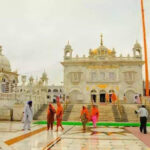Adhan (Arabic: [aan]; sometimes transliterated as athan, adhane (in French), azan/azaan (in South Asia), adzan (in Southeast Asia), and ezan (in Turkish), among other languages[2]) is the Islamic summons to public prayer (salah) delivered by a muezzin at designated times of the day.
On ordinary days, Adhan is chanted five times a day from the mosque, and all day long on the Islamic festivals of Eid al-Fitr and Eid al-Adha, customarily from the tower. It is the first summons to Muslims to enter the mosque for compulsory (fard) prayer (salah). A second call, known as the iqamah, asks everyone within the mosque to form a line for the start of the prayers.
Only in Turkey is Ezan sung in five different ways at various times: saba, uşşak, hicaz, rast, and segah.
Adhn, Arabic for “announcement,” comes from the root adhina, which means “to listen, to hear, to be told about.” It is transliterated differently in different cultures.
Athan, or adhane (in French),[1] azan in Iran and south Asia (in Persian, Dari, Pashto, Hindi, Bengali, Urdu, and Punjabi), adzan in Southeast Asia (Indonesian and Malaysian), and ezan in the Middle East (in Turkish).
The call to public prayer is known as Banku among Muslims on India’s Malabar Coast.
Adhn has another descendant, udhun (), which means “ear.”
The muezzin (Arabic: muain) is the person responsible for reciting the Adhan: 470 from the mosque. In modern times, this is frequently done with a microphone: a recitation that is then broadcast to the speakers, which are normally located on the highest section of the mosque’s minarets, calling those nearby to prayer. The message, however, can be recorded in numerous mosques. This is because the “call to prayer” must be repeated aloud at least five times every day. This is typically accomplished by replaying a previously recorded “call to prayer” in the absence of a muezzin.
This allows the mosque operator to alter or mix the message and adjust the volume of the message without not needing to hire a full-time muezzin or in the absence of a muezzin. As a result, in many Muslim countries, the sound of the prayer call can be the same between mosques, as well as between Salah hours, as is the case with the London Central Mosque. In the case of religious occasions such as Eid al-Fitr, where the Kalimah (speech) must be recited out loud all day, mosque operators employ this recording approach to generate a looping recitation of the Kalimah.
The muezzin is picked because of his ability to recite the Adhan, melodically, and loudly enough for all Muslims to hear. This is one of his most essential responsibilities in the mosque, as his companions and community rely on him to summon Muslims to congregational prayer. The prayer is led five times a day by the Imam. Bilal ibn Rabah, a freed slave of Abyssinian descent, was Islam’s first muezzin.
According to Sunni Sunnis, the adhan was not written or spoken by the Islamic prophet, Muhammad, but by one of his Sahabah (his companions). Abdullah ibn Zayd, a sahabi of Muhammad, had a dream vision in which God conveyed the call to prayer to him. He afterward told his companions about it. In the meantime, this information reached Muhammad, who corroborated it. Muhammad chose a freed Habeshan slave named Bilal ibn Rabah al-Habashi to make the call to prayer because of his beautiful voice. The call was chosen by Muhammad over the use of bells (as used by Christians) and horns (as by the Jews).
There is one adhan during Friday prayer (Salat al-Jumu’ah), but some Sunni Muslims expand it to two; the first is spoken to summon people to the mosque, and the second is said before the Imam begins the khutbah (sermon). As with all prayers, the iqama is said by someone among the praying people just before the prayers begin. The rationale for this is that during the reign of Caliph Uthman, he ordered two adhans to be made: the first in the marketplace to alert people that Friday prayer was about to begin and the second in the mosque. Not all Sunnis favor two adhans since the necessity to notify people of impending prayer times is no longer necessary now that the times for prayers are well established.
Shia
According to Shia Shia texts, Muhammad ordered the adhan as a manner of summoning Muslims to pray based on God’s command. According to Shia Islam, no one else has any power to contribute to the composition of the adhan. Shia accounts also claim that Bilal ibn Rabah al-Habashi was the first individual to openly recite the Adhan in front of a Muslim congregation. The fundamental phrase l Ilha ill llh is the cornerstone of Islam, as is belief in it. It proclaims, “There is no god but God.” This is the Tawhid confession, often known as the “doctrine of God’s Oneness.”







